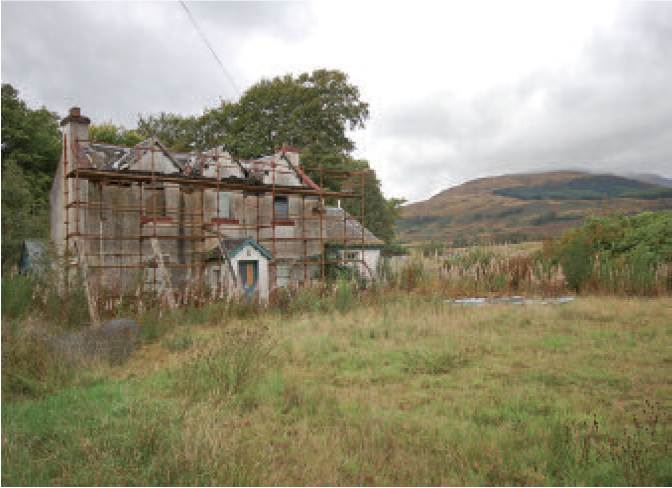
In a post last week (see here) I explained how the LLTNPA had landscaped the area its owns by Loch Venachar House to block off access and how it is no longer possible to walk round the shore of Loch Venachar from the car park to Loch Venachar dam. In this post I will look at how the LLTNPA dealt with the planning application for Loch Venachar House, to which its Convener Linda McKay was a joint party, but first how subsequently access to the shoreline has since been expropriated.
Access to the shore of Loch Venachar
The biggest issue relating to the development of the new Loch Venachar House came after the final application in 2013. All the planning applications were for a property whose boundaries did not extend to the shores of Loch Venachar. The LLTNPA therefore had no reason to consider any potential access issues created by the development because it could be assumed that access along the shore of Loch Venachar would continue.
What then appears to have happened however is that the land between the house and the loch shore was either bought or leased and incorporated into the garden of Venachar House. The best map that illustrates this is the one associated with the 2006 application:
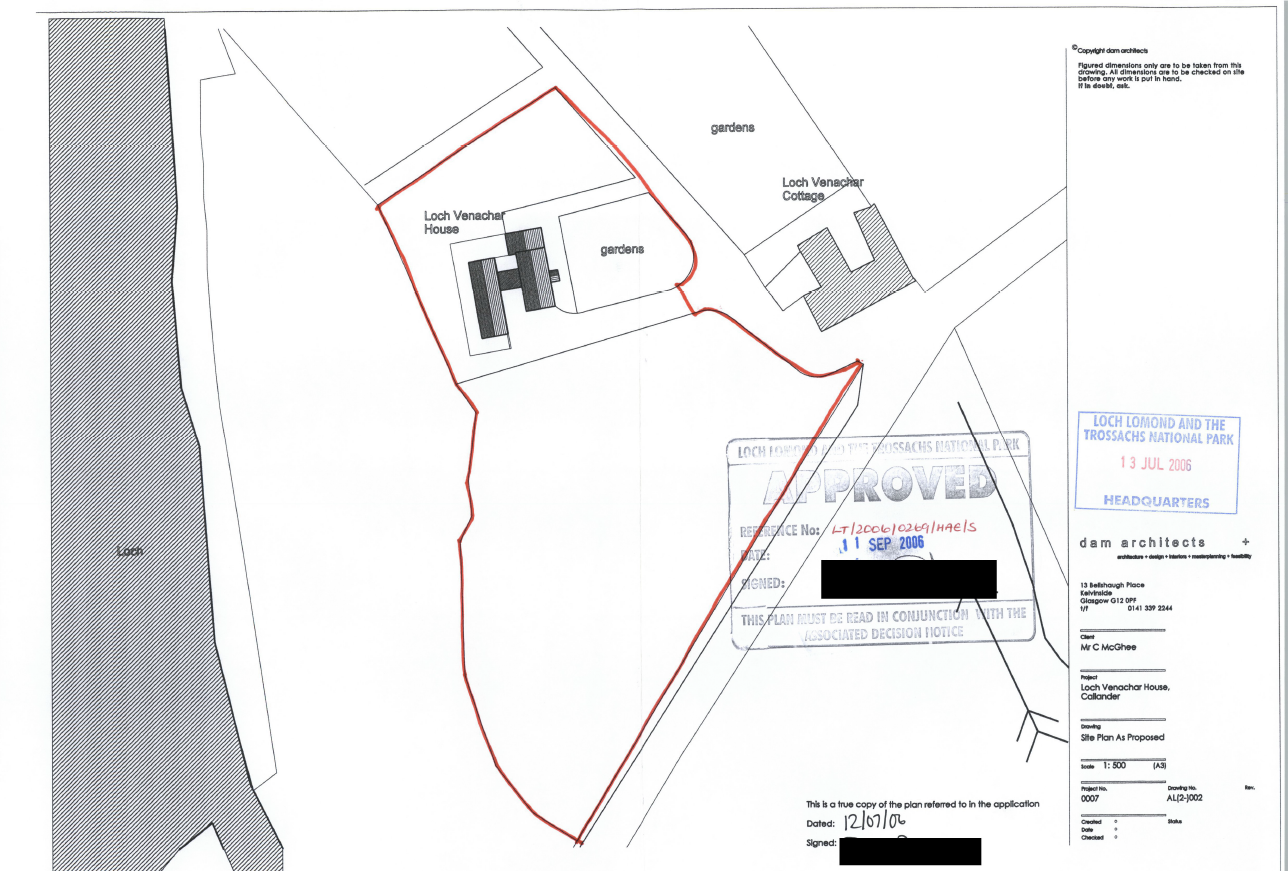
No further planning permission was applied for. In my view this should have required planning permission because its effect has been to stop the public walking along the shore.
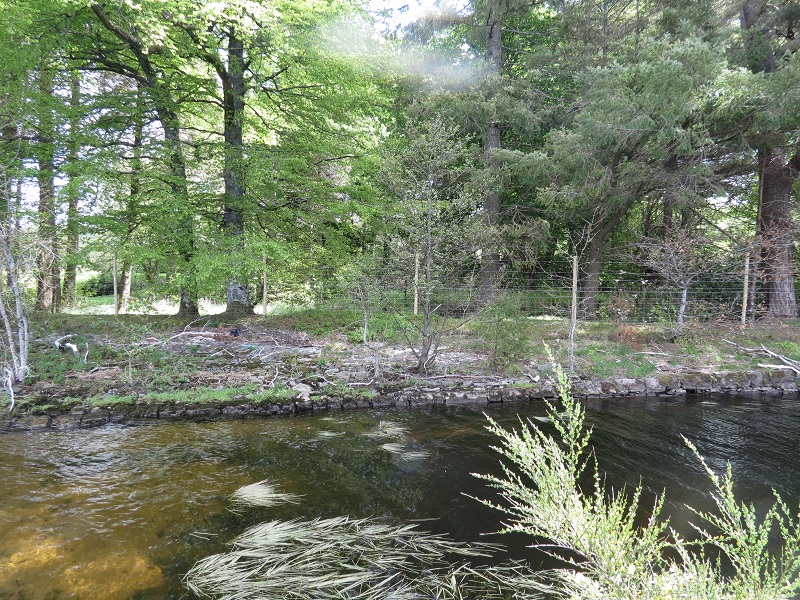
And access to the piece of ground in front of the fence, as shown in the previous post, has been blocked off to the public, at least for the last nine months.
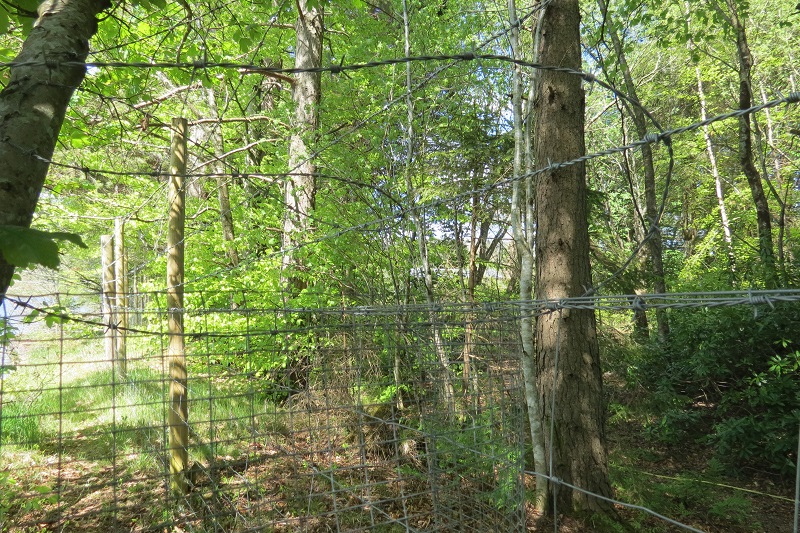
How does any of this fit with the National Park’s statutory aim of promoting public enjoyment of the countryside? We know that Linda McKay, as Park Convener personally led the attempt to try and get the Land Reform Review Group to remove the right to camp by roads (see here) but it also appears she has placed her personal interests in respect of her property before the access rights of the public. She may have the legal right to do so but how in Scotland we could have ever allowed such a person to be elected convener of a National Park Authority and then lead the introduction of camping byelaws is a question that needs answering.
The planning history and applications
Loch Venachar House had been publicly owned, being originally built by the Glasgow Corporation as part of the Loch Venachar waterworks (see here) as a store, had been converted into a house but was abandoned in 1995 and had become derelict. It was then sold by Scottish Water.
In 2002 a planning application was submitted to redevelop the old house but then withdrawn. In 2004 a planning application from S.McGhee to redevelop the property was refused by the newly created LLTNPA as it contravened Stirling’s local plan and policies (see here). The reasons for this included the size of the proposed new extension compared to the existing house, the angle of the roof was too low and there was too much glazing.
In 2006 a revised application from Mr McGhee was approved. There is then a gap in the planning history during which time the property was marketed by Bell Ingram (top photo) and then bought on 16th July 2010 for £250,000 according to a house price website.
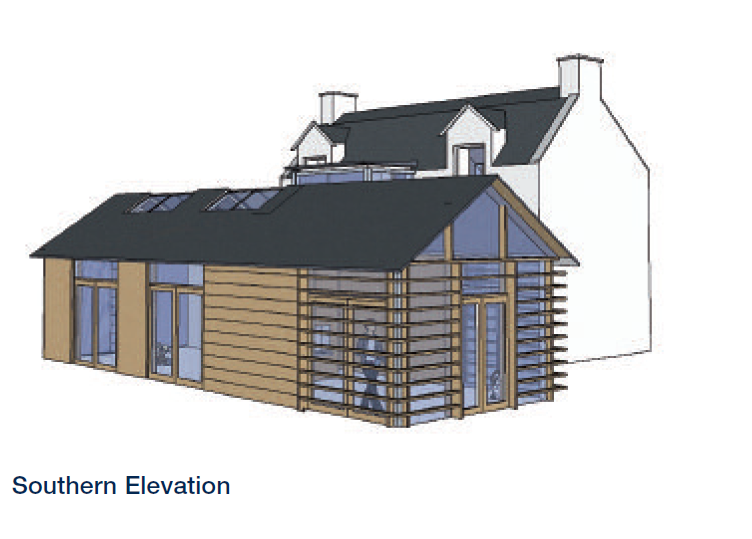
In 2011 a revised planning application was submitted to the LLTNPA by John Young and Linda Mackay, who was by then convener of the National Park Authority, to demolish the existing house and replace it with a house of similar footprint. The existing house had been found to be structurally unsafe by engineers and beyond repair. While much of the stone was judged unusable the LLTNPA required that that which was salvageable should be reused in building a new chimney because planning policy was that “The re-use of materials arising from demolition is maximised”. The application was determined by Committee rather than officers because Linda Mackay was a Board Member 2011_0161_DET-Committee_report_final-72143.
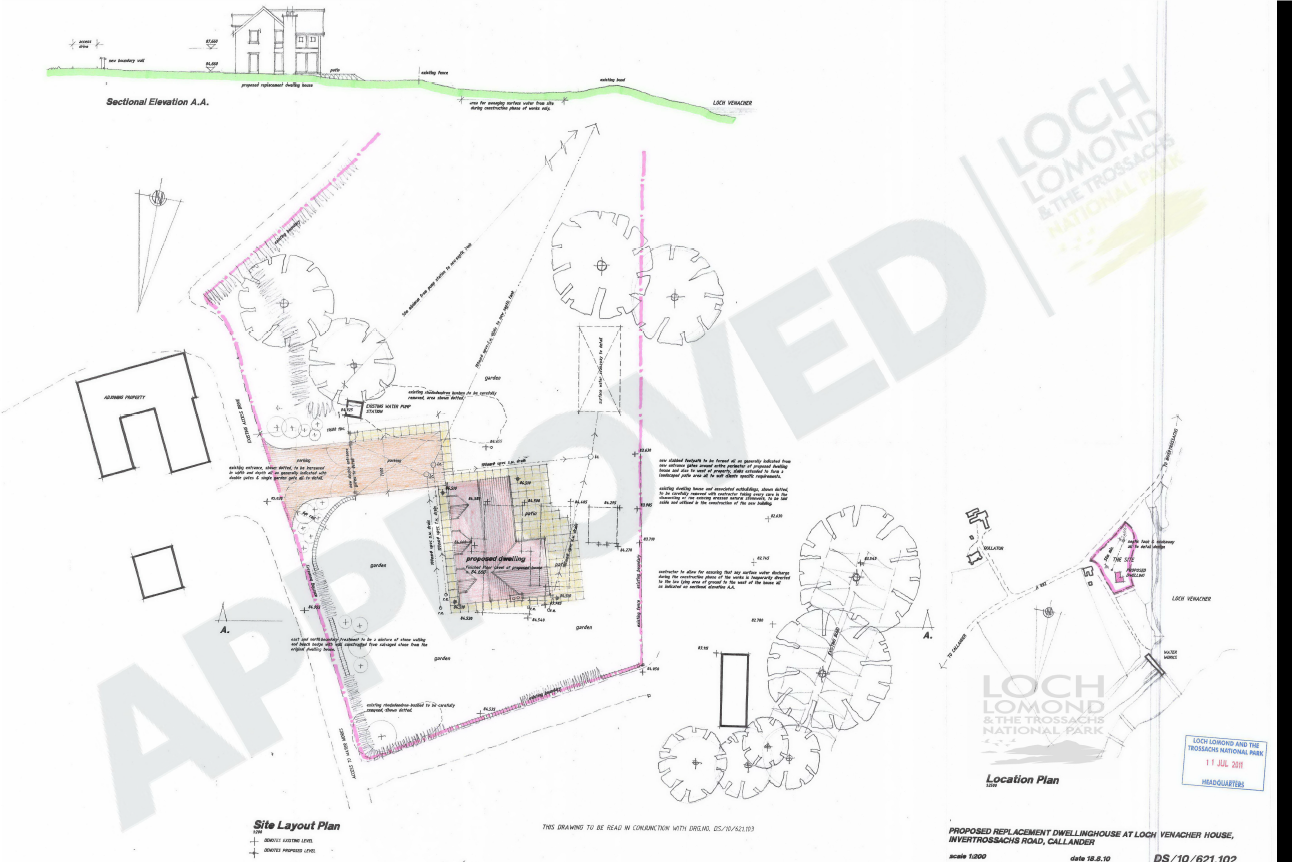
While the conditions attached to the planning application were quite vague – and that matters in legal terms because its conditions rather than comments on the merit of an application that ultimately count and the applicant was not bound in this place to carry out the plans – the process otherwise appears to have been exemplary and there is no reason to question that the house needed to be knocked down.
In 2012, a new planning application was submitted to the LLTNPA, after the old house had been demolished, for a totally new design of house.
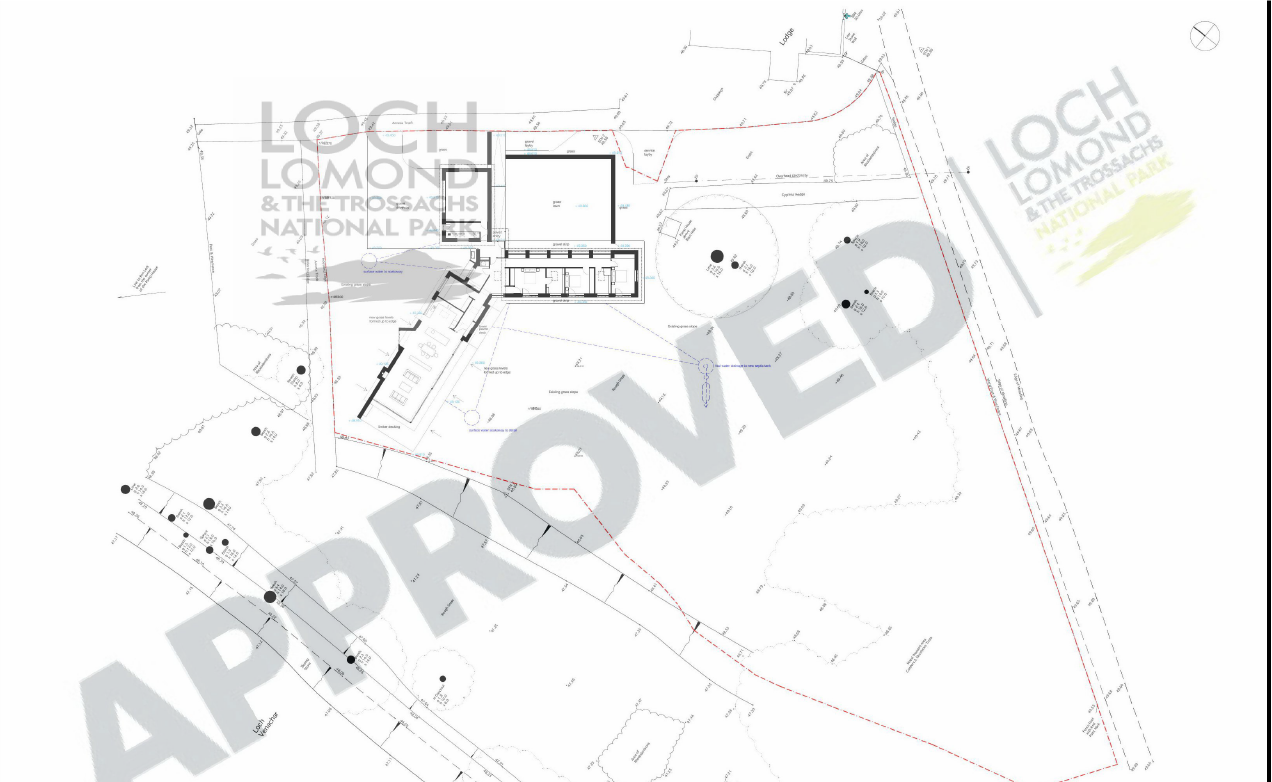
This surprised me, why would someone apply for planning permission for one thing, gain it, and then after demolishing the property apply for something completely different? I have however checked with planning experts and there is nothing to unlawful about anyone who has been given permission to demolish a house, to replace it with a new house of a specific design, from then submitting a completely new application once they have demolished the house as happened in this case. The reason for this apparently sudden change in plan is not explained in the Committee Report on the revised application (see here). The Committee approved the application. Because the minutes are no longer published on the LLTNPA website, its not possible to see whether Owen McKee, the then chair of planning, who was forced to resign from the LLTNPA for failing to declare interests (see here), chaired the meeting.
The consequence of the Committee approval is that the house which was built by Linda McKay and John Young was totally different to the original house and the plans which had been approved the year before.
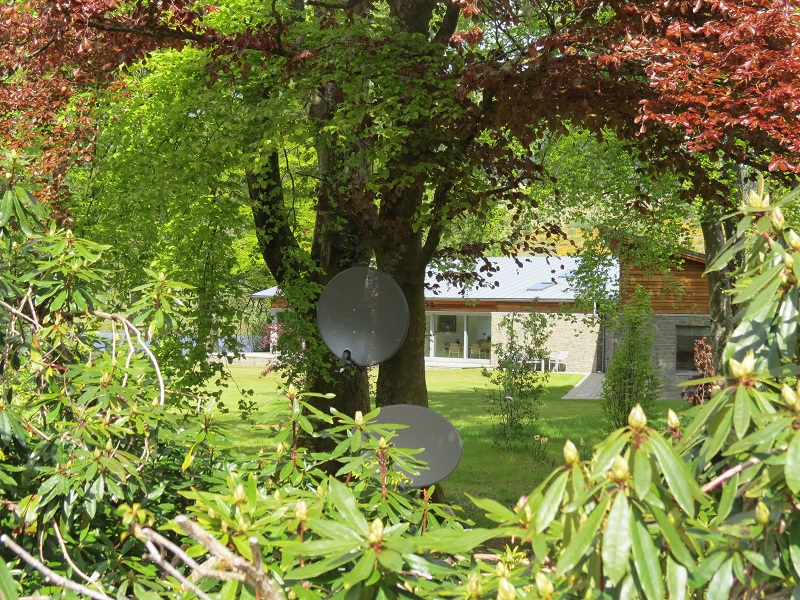
The new building has won architectural awards (see here for photos).
The wording of the Committee Report was unclear about whether all the stone from the old building, some of which due to be re-used, was removed from the site:
.
On account of this, I asked the LLTNPA what information they held on this “approval” and received this reply:

In my view this does not answer the question. The Committee Report says approval was given to remove the stone but the previous planning report had said the re-salveagable stone would be re-used. Its not clear that it was. At least as a result of other questions I asked about this development the Park did put the older planning applications onto the planning portal – a welcome step in the right direction in terms of transparency EIR 2016-003 Response
The more fundamental issues here however are two-fold:
The National Park planning process.
If you read the Planning Reports from 2002 to 2012 they start by trying to replicate the footprint and size of the original building and end up agreeing to a completely different type of house. The message appears to be that if you own a traditional building, there will be very limited things you will be allowed to do with it, but if you allow that building to fall into sufficient state of disrepair (and that Loch Venachar House was in a state of disrepair was clearly not Linda McKay’s responsibility) you can do anything. This appears to me to be an invitation to developers to buy buildings, let them collapse and you can then do whatever you want. Now I am not against new buildings and I think most people would agree Loch Venachar House is a very nice house, the issue though is about consistency of the planning process.
During the time-span covered by these applications planning policy in the Park has changed but its still difficult to see how what has happened at Loch Venachar House reflects the latest policy as expressed in the Park’s Local Development Plan:
Historic Environment Policy 3:Wider Built Environment and Cultural Heritage
Development proposals will be expected to protect, conserve and/or enhance a building or feature of architectural and/or historical merit or of cultural significance. Buildings or features of merit which are important to the cultural heritage of the National Park should be retained and incorporated in new developments where possible and any adverse impacts of the development should be avoided or mitigated.
The message this case gives.
While nothing unlawful has been done, and while there may have been a very good reason for Linda McKay’s radical change in her plan after the old Loch Venachar House had been demolished, this has not been explained publicly. The message that unscrupulous developers who want to get around Historic Environment Policy 3 could take from this, therefore, is that the chances of getting planning permission to redevelop buildings within the National Park appear to improve if first you apply to build something similar to what is already on site and then, once the building is demolished, you submit new plans. I think that is extremely unfortunate and it potentially puts the LLTNPA planners in a difficult position if similar situations recur in future.
To put this in perspective though there are plenty of other policies in the LLTNPA which are not worth the paper they are written on, including for example design of hydro schemes (see here for example) but the importance of this case is it does involve the person who till 28th February 2017 has been Convener of the National Park Authority. In my view its important that those on National Park Board not only follow the rules, but the LLTNPA can show they have followed the spirit of these rules. On the information that is available there are legitimate questions to be asked about this.
What needs to happen
Its too late to do anything about the planning applications now but the LLTNPA needs to set an example and re-establish access along the shores of Loch Venachar by whatever means necessary, including compulsory purchase if Linda McKay fails to co-operate.
James Stuart, the new convener of the LLTNPA needs to set a new direction for the National Park and a core part of that should be to re-affirm that its NATIONAL, works for national as well as local interests, and there is no place for NIMBYISM anywhere in the National Park
The irregularities in the planning department are very concerning, Their own claim the the planning authority is a separate and independent entity from the Park Authority is fiction.
The Planning Authority fail abysmally in many aspect of good planning practice including openness, accountability and enforcement. The planing portal sequential numbering system seems to show many missing applications. There is a lack of transparency in the whole process. The intimate ties between the park authority and the planning authority is unhealthy and planning for the National Park should be put back in the hands of a responsible planning Authority.
As to the irregularities highlighted at Loch Vennacher House, At this level, this should be properly investigated by Government Ministers. Any doubt that the actions of the Planning Authority is allowing passing these alterations and any involvement of LLTNP in implementing fencing and other modifications for the benefit of a board member should be clarified. to restore public confidence.
An immediate investigation is called for into the Governance at Loch Lomond and The Trossachs National Park both in connection with this series of planning applications and other irregularities in the Governance Process.
In any case all planning application related to all board members past and present should be reinstated on the planning portal to allow public scrutiny. I for one have no confidence in the governance of the National Park Authority or it’s Planning Authority.
Very interesting especially the we can’t do the maximum reuse because they are already of site excuse it would be very enlightenin to have a little snorkel or underwater camera just to poke around the shore at the location
Corrupt rotten to the core lower than a snakes belly
Today my children and I went for our allowed daily family walk. We walked from Callander and along the rocky shore (water was low) to get to the dam. We did not sit, we did not have a BBQ , sunbathe or anything else. On the way back along the shore (clearly on the Loch Venacher side of any walls, fenses or boundaries) we were verbally abused by a lady telling us we were on her private beach. Is correct? I would hate to be seen to trespass and have been following all social distancing rules to the letter.
Hi, I don’t normally accept anonymous comments but recognise your need to do so in the circumstances. Its great you got out and, by the way, under the law you are not restricted to walking once a day or just for an hour. The short answer is no, unless you have stepped over into a garden or somewhere else exempt from access rights, you have a right of access and in almost all circumstances access rights exist on beaches. Could you confirm whether the lady who you allege accosted you came from Venachar House and also if you have any evidence of what happened, I would be very interested in seeing this. Nick
This morning I woke up to a whatsapp link to your article from a friend who had had a sleepless night. She was up in the small hours researching Venachar House. This moonlight sleuthing was brought on by a similarly unpleasant incident to the one described above the prior evening. We had arrived on the beach from the road just beyond Venachar House but returned via the dam. I’m a civil engineer and a bit of a geek for Victorian waterworks (I know each to their own). I also work with Scottish Water on projects that seek to harvest energy from water infrastructure and was interested in the dam as a possible location. While I was taking in the unique angular design of the original fish pass I became aware that I was being watched from the House. When we made to leave via the path to the main road a lady emerged from the House and made her way to the gate halfway up the path. She came through closing the gate behind her and tried to stop us from going any further. My reading of the situation was that the path gave access to the dam which being owned by Scottish Water is a public asset. To my mind no private individual has the right to block access to a public asset. This seems commonsense to me. I am not a lawyer however. The situation grew quite tense and my friend was quite disturbed. The lady’s neighbour emerged and seemed to take on the role of “threatening dog” in the background. I made it clear I had no intention of retreating back along the beach on the grounds that the dam was a publicly owned asset and that there was no signage or fencing on the access route. As we walked passed the lady through the gate she hollered behind us to her neighbour: “Its okay they wont be back!” What are the rules regarding this route?